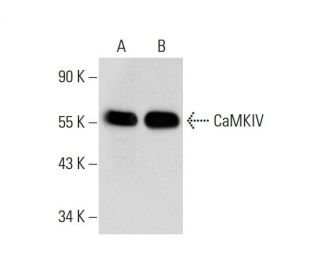
CaMKIV Antikörper (A-3): sc-166156
- CaMKIV Antikörper (A-3) ist ein Maus monoklonales IgG2b κ, verwendet in 5 wissenschaftlichen Veröffentlichungen, in einer Menge von 200 µg/ml
- spezifisch für ein Epitop, welches zwischen den Aminosäuren 423-461 am C-terminus von CaMKIV aus der Spezies human liegt
- CaMKIV Antikörper (A-3) ist empfohlen für die Detektion von CaMKIV and Calspermin aus der Spezies human per WB, IP, IF, IHC(P) und ELISA
- Anti-CaMKIV Antikörper (A-3) ist erhältlich als Konjugat mit Agarose für IP; HRP für WB, IHC(P) und ELISA; und entweder mit Phycoerythrin oder FITC für IF, IHC(P) und FCM
- auch erhältlich als Konjugat mit Alexa Fluor® 488, Alexa Fluor® 546, Alexa Fluor® 594 oder Alexa Fluor® 647 für IF, IHC(P) und FCM
- auch erhältlich als Konjugat mit Alexa Fluor® 680 oder Alexa Fluor® 790 für WB (NIR), IF und FCM
- 2b BP-HRP">m-IgG2b BP-HRP und m-IgGκ BP-HRP sind die bevorzugten sekundären Nachweisreagenzien für CaMKIV Antikörper (A-3) für WB- und IHC(P)-Anwendungen. Diese Reagenzien werden jetzt in Bündeln mit CaMKIV Antikörper (A-3) angeboten(siehe Bestellinformationen unten).
Der CaMKIV-Antikörper (A-3) ist ein monoklonaler Maus IgG2b κ CaMKIV-Antikörper (auch als CaMKIV-Antikörper oder CAMK4-Antikörper bezeichnet), der CaMKIV und Calspermin von humaner Herkunft durch WB, IP, IF, IHC (P) und ELISA nachweist. Der CaMKIV-Antikörper (A-3) ist als nicht konjugierte Form des Anti-CaMKIV-Antikörpers sowie als mehrere konjugierte Formen des Anti-CaMKIV-Antikörpers, einschließlich Agarose, HRP, PE, FITC und mehreren Alexa Fluor®-Konjugaten, erhältlich. Die Ca2+/Calmodulin-abhängigen Protein-Kinasen (CaM-Kinasen) umfassen eine strukturell verwandte Unterfamilie serin-/threonin-spezifischer Kinasen, die CaMKI, CaMKII und CaMKIV umfassen. CaMKII ist eine ubiquitär exprimierte serin-/threonin-spezifische Protein-Kinasen, die durch Ca2+ und Calmodulin (CaM) aktiviert wird und in der Regulation des Zellzyklus und der Transkription impliziert ist. Es gibt vier CaMKII-Isoenzyme, die als α, β, γ und δ bezeichnet werden, die in einem bestimmten Gewebetyp möglicherweise oder auch nicht ko-exprimiert werden. CaMKIV wird durch Ca2+ und CaM stimuliert, erfordert aber auch eine Phosphorylierung durch eine CaMK für die vollständige Aktivierung. Die Stimulation des T-Zell-Rezeptor-CD3-Signalkomplexes mit einem Anti-CD3-Antikörper führt zu einer 10- bis 40-fachen Erhöhung der CaMKIV-Aktivität. Eine zusätzliche Kinase, CaMKK, dient zur Aktivierung von CaMKI durch die spezifische Phosphorylierung der regulativen Threonin-Reststelle an Position 177.
Alexa Fluor® ist ein Markenzeichen von Molecular Probes Inc., OR., USA
LI-COR® und Odyssey® sind Markenzeichen von LI-COR Biosciences
CaMKIV Antikörper (A-3) Literaturhinweise:
- Beitrag von CaMKIV zu verletzungs- und angstinduzierten Ultraschallvokalisationen bei erwachsenen Mäusen. | Ko, SW., et al. 2005. Mol Pain. 1: 10. PMID: 15813959
- ER81 und CaMKIV identifizieren anatomisch und phänotypisch definierte Untergruppen von Interneuronen im Bulbus olfactorius der Maus. | Saino-Saito, S., et al. 2007. J Comp Neurol. 502: 485-96. PMID: 17394138
- Beteiligung von CaMKIV an der neurogenen Wirkung bei chronischer Fluoxetin-Behandlung. | Song, N., et al. 2013. Int J Neuropsychopharmacol. 16: 803-12. PMID: 22695008
- Die Stimulation des Sigma-1-Rezeptors verbessert depressionsähnliche Verhaltensweisen bei CaMKIV-Null-Mäusen. | Moriguchi, S., et al. 2015. Mol Neurobiol. 52: 1210-1222. PMID: 25316382
- Das camKK2/camKIV-Relais ist ein wesentlicher Regulator von Leberkrebs. | Lin, F., et al. 2015. Hepatology. 62: 505-20. PMID: 25847065
- Erforschung der Rolle von CaMKIV in der homöostatischen Plastizität. | Bleier, J. and Toliver, A. 2017. J Neurosci. 37: 11520-11522. PMID: 29187612
- Die Aktivierung der Calcium/Calmodulin-abhängigen Proteinkinase IV (CaMKIV) trägt über die Hemmung der Proliferation von Darmepithelzellen zur Pathogenese der experimentellen Kolitis bei. | Cunningham, KE., et al. 2019. FASEB J. 33: 1330-1346. PMID: 30113881
- Sevofluran induziert die Entzündung von Mikroglia im Hippocampus neonataler Ratten durch Hemmung des Wnt/β-Catenin/CaMKIV-Wegs. | Wang, F., et al. 2021. J Pharmacol Sci. 146: 105-115. PMID: 33941321
- Nrf2 verbessert die synaptische Plastizität, das Lernen und das Gedächtnis im Hippocampus durch das circ-Vps41/miR-26a-5p/CaMKIV-Regulationsnetzwerk. | Zhang, R., et al. 2022. Exp Neurol. 351: 113998. PMID: 35143833
- CaMKIV vermittelt bei kongenitaler Hypothyreose einen Mangel an Wirbelsäulenwachstum von Hippocampus-Neuronen durch Regulierung der EGR3/BDNF-Signalachse. | Wu, H., et al. 2022. Cell Death Discov. 8: 482. PMID: 36473844
Bestellinformation
| Produkt | Katalog # | EINHEIT | Preis | ANZAHL | Favoriten | |
CaMKIV Antikörper (A-3) | sc-166156 | 200 µg/ml | RMB2377.00 | |||
CaMKIV (A-3): m-IgGκ BP-HRP Bundle | sc-521524 | 200 µg Ab, 40 µg BP | RMB2662.00 | |||
CaMKIV (A-3): m-IgG2b BP-HRP Bundle | sc-548920 | 200 µg Ab; 10 µg BP | RMB2662.00 | |||
CaMKIV Antikörper (A-3) AC | sc-166156 AC | 500 µg/ml, 25% agarose | RMB3129.00 | |||
CaMKIV Antikörper (A-3) HRP | sc-166156 HRP | 200 µg/ml | RMB2377.00 | |||
CaMKIV Antikörper (A-3) FITC | sc-166156 FITC | 200 µg/ml | RMB2482.00 | |||
CaMKIV Antikörper (A-3) PE | sc-166156 PE | 200 µg/ml | RMB2580.00 | |||
CaMKIV Antikörper (A-3) Alexa Fluor® 488 | sc-166156 AF488 | 200 µg/ml | RMB2685.00 | |||
CaMKIV Antikörper (A-3) Alexa Fluor® 546 | sc-166156 AF546 | 200 µg/ml | RMB2685.00 | |||
CaMKIV Antikörper (A-3) Alexa Fluor® 594 | sc-166156 AF594 | 200 µg/ml | RMB2685.00 | |||
CaMKIV Antikörper (A-3) Alexa Fluor® 647 | sc-166156 AF647 | 200 µg/ml | RMB2685.00 | |||
CaMKIV Antikörper (A-3) Alexa Fluor® 680 | sc-166156 AF680 | 200 µg/ml | RMB2685.00 | |||
CaMKIV Antikörper (A-3) Alexa Fluor® 790 | sc-166156 AF790 | 200 µg/ml | RMB2685.00 | |||
CaMKIV (A-3) Neutralizing Peptid | sc-166156 P | 100 µg/0.5 ml | RMB511.00 |
